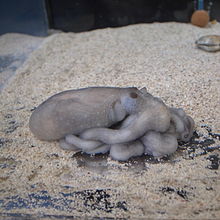
Back اخطبوط صغير ARZ Octopus minor CEB Langarm-Oktopus German Octopus minor French Octopus minor ID Octopus minor Italian 낙지 Korean Octopus minor Dutch Octopus minor Russian Octopus minor Swedish
| Octopus minor | |
|---|---|

| |
| Scientific classification | |
| Domain: | Eukaryota |
| Kingdom: | Animalia |
| Phylum: | Mollusca |
| Class: | Cephalopoda |
| Order: | Octopoda |
| Family: | Octopodidae |
| Genus: | Callistoctopus |
| Species: | C. minor
|
| Binomial name | |
| Callistoctopus minor (Sasaki, 1920)
| |
| Synonyms | |
| |
Octopus minor (more strictly Callistoctopus minor), also known as the long arm octopus or the Korean common octopus, is a small-bodied octopus species distributed along the benthic coastal waters bordering China, Japan, and the Korean Peninsula. It lives at depths ranging from the sea surface to 200 metres (650 feet; 100 fathoms).[1][2] O. minor is commonly found in the mudflats of sub-tidal zones where it is exposed to significant environmental variation.[3] It is grouped within the class Cephalopoda along with squids and cuttlefish.[4]
O. minor carries cultural and economic value in the countries in which it is found. It is important commercially to the fishing communities in Korea, where it contributes to the $35 million octopus industry.[5] It is a Korean seafood, commonly referred to as nakji (Korean: 낙지). The octopus is served both cooked and raw, and is often a snack during sporting events.[6]
There have been multiple findings concerning the physiological makeup of O. minor. It has been shown to host a dangerous parasite, while also demonstrating the ability to adapt its morphology to a wide range of environmental conditions. These characteristics have increased interest in the species and its genome has been mapped.[3][7]
- ^ Lifeng, Li (March 2006). "Coastal Mollusks of the Yellow Sea Ecoregion and their habitats" (PDF). Coastal Mollusks of the Yellow Sea Ecoregion and their habitats. Retrieved 23 April 2020.
- ^ "Editorial board". Marine Behaviour and Physiology. 3 (3): ebi. January 1975. doi:10.1080/10236247509378505. ISSN 0091-181X.
- ^ a b Kim, Bo-Mi; Kang, Seunghyun; Ahn, Do-Hwan; Jung, Seung-Hyun; Rhee, Hwanseok; Yoo, Jong Su; Lee, Jong-Eun; Lee, SeungJae; Han, Yong-Hee; Ryu, Kyoung-Bin; Cho, Sung-Jin (2018-09-25). "The genome of common long-arm octopus Octopus minor". GigaScience. 7 (11). doi:10.1093/gigascience/giy119. ISSN 2047-217X. PMC 6279123. PMID 30256935.
- ^ Vendetti, J (2006). "The Cephalopoda".
- ^ Glionna, J (2010). "South Korean fisherman, Health officials tangle over Octopus". Los Angeles Times. Retrieved 24 April 2020.
- ^ Raskin, Hanna (2013-01-22). "Nakji bokkeum, the classic Korean octopus dish that's a stated specialty of". Seattle Weekly. Retrieved 2020-05-26.
- ^ Du, Xin; Dong, Chao; Sun, Shi-Chun (2018-10-01). "Octopicola huanghaiensis n. sp. (Copepoda: Cyclopoida: Octopicolidae), a new parasitic copepod of the octopuses Amphioctopus fangsiao (d'Orbigny) and Octopus minor (Sasaki) (Octopoda: Octopodidae) in the Yellow Sea". Systematic Parasitology. 95 (8–9): 905–912. doi:10.1007/s11230-018-9819-8. ISSN 0165-5752. PMID 30276653. S2CID 52896143.